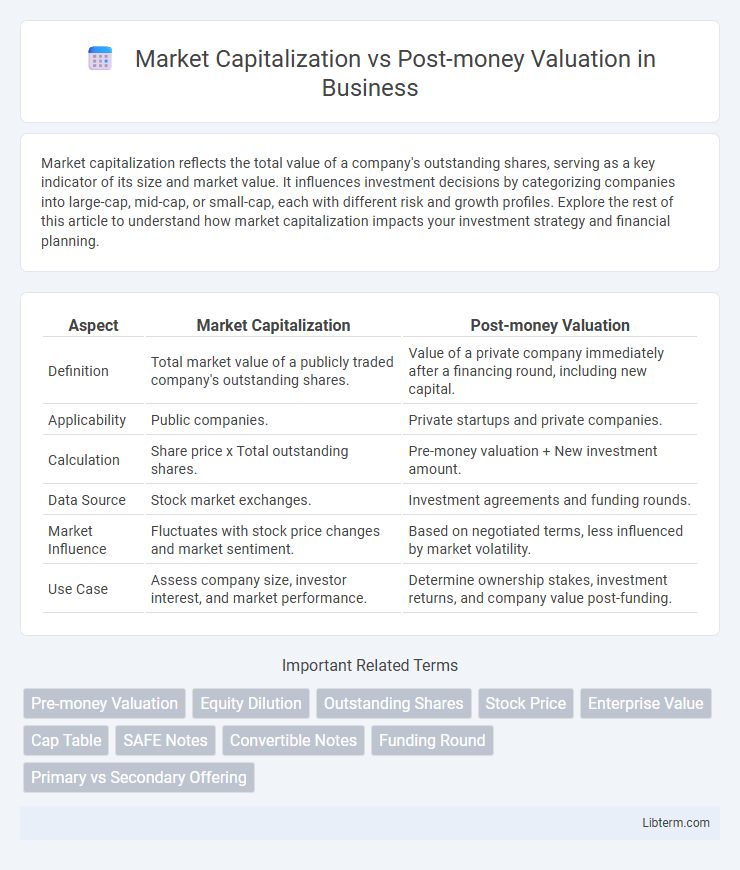Market capitalization reflects the total value of a company's outstanding shares, serving as a key indicator of its size and market value. It influences investment decisions by categorizing companies into large-cap, mid-cap, or small-cap, each with different risk and growth profiles. Explore the rest of this article to understand how market capitalization impacts your investment strategy and financial planning.
Table of Comparison
| Aspect | Market Capitalization | Post-money Valuation |
|---|---|---|
| Definition | Total market value of a publicly traded company's outstanding shares. | Value of a private company immediately after a financing round, including new capital. |
| Applicability | Public companies. | Private startups and private companies. |
| Calculation | Share price x Total outstanding shares. | Pre-money valuation + New investment amount. |
| Data Source | Stock market exchanges. | Investment agreements and funding rounds. |
| Market Influence | Fluctuates with stock price changes and market sentiment. | Based on negotiated terms, less influenced by market volatility. |
| Use Case | Assess company size, investor interest, and market performance. | Determine ownership stakes, investment returns, and company value post-funding. |
Introduction to Market Capitalization and Post-money Valuation
Market capitalization represents the total market value of a publicly traded company's outstanding shares, calculated by multiplying the current share price by the total number of shares. Post-money valuation reflects the value of a company immediately after receiving external funding, incorporating the investment amount into the company's pre-money valuation. Understanding the distinction is crucial for investors and founders as market capitalization indicates current market perception, while post-money valuation highlights a company's worth following financing rounds.
Defining Market Capitalization
Market capitalization refers to the total market value of a company's outstanding shares of stock, calculated by multiplying the current stock price by the total number of outstanding shares. It reflects the public market's valuation of a company and fluctuates with stock price changes. Market capitalization differs from post-money valuation, which is used primarily in private funding rounds and incorporates new investments made during fundraising.
Defining Post-money Valuation
Post-money valuation represents the company's value immediately after receiving external financing or investment, calculated by adding the investment amount to the pre-money valuation. This metric is crucial for determining the ownership percentage of new investors and equity dilution among existing shareholders. Unlike market capitalization, which reflects the total market value of a publicly traded company's outstanding shares, post-money valuation is primarily used in private funding rounds and startup financing.
Key Differences Between Market Cap and Post-money Valuation
Market capitalization represents the total value of a company's outstanding shares in the public market, calculated by multiplying the current share price by the number of shares outstanding. Post-money valuation refers to a company's estimated worth immediately after receiving external funding, including the new equity investment. Unlike market cap, which fluctuates with stock price changes on public exchanges, post-money valuation is static until the next funding round or valuation event.
Factors Influencing Market Capitalization
Market capitalization is primarily influenced by a company's current share price and the total number of outstanding shares, reflecting real-time market sentiment and investor demand. Key factors affecting market capitalization include financial performance, growth prospects, industry trends, macroeconomic conditions, and investor perception of risk and opportunity. Unlike post-money valuation, which is determined during funding rounds based on agreed-upon investment amounts and ownership percentages, market capitalization fluctuates continuously with market dynamics and trading activity.
Factors Affecting Post-money Valuation
Post-money valuation is influenced by factors such as the amount of capital raised in a funding round, investor demand, and the company's growth potential, which directly impact the perceived market value. Unlike market capitalization, which is primarily driven by current stock price multiplied by outstanding shares, post-money valuation accounts for the latest equity infusion and ownership dilution. The stage of the company, comparable market transactions, and macroeconomic conditions also critically affect post-money valuation outcomes.
Calculation Methods for Market Cap and Post-money Valuation
Market capitalization is calculated by multiplying the current share price by the total number of outstanding shares, reflecting the company's equity market value at a given point. Post-money valuation is determined by adding the investment amount in a funding round to the pre-money valuation, representing the company's value immediately after receiving new capital. These calculation methods differ as market cap fluctuates with stock price changes, while post-money valuation is fixed based on investment terms during financing events.
Practical Examples: Market Cap vs Post-money Valuation
Market capitalization is calculated by multiplying a company's current stock price by its total outstanding shares, reflecting the company's public market value. Post-money valuation represents the company's value immediately after an investment round, calculated by adding new funding to the pre-money valuation, commonly used in private startups during fundraising. For example, a publicly traded company with 10 million shares at $50 per share has a market cap of $500 million, while a startup that raised $20 million on a $80 million pre-money valuation has a post-money valuation of $100 million.
Relevance for Investors and Companies
Market capitalization represents the total market value of a company's outstanding shares, providing investors with a real-time snapshot of public company value based on stock price fluctuations. Post-money valuation refers to the company's value immediately after receiving external financing or investment, offering startups and private companies a critical benchmark for ownership percentages and fundraising success. Understanding both metrics is essential for investors assessing investment potential and for companies negotiating funding rounds or evaluating growth trajectories.
Conclusion: Choosing the Right Metric
Selecting between market capitalization and post-money valuation depends on the context and purpose of the financial analysis. Market capitalization reflects the current market value of a publicly traded company, making it ideal for assessing investor sentiment and market trends, while post-money valuation is primarily used during funding rounds to understand a startup's worth immediately after investment. Accurate decision-making requires prioritizing market cap for liquidity and market perception insights, and post-money valuation for evaluating investment stakes and future growth potential.
Market Capitalization Infographic

 libterm.com
libterm.com